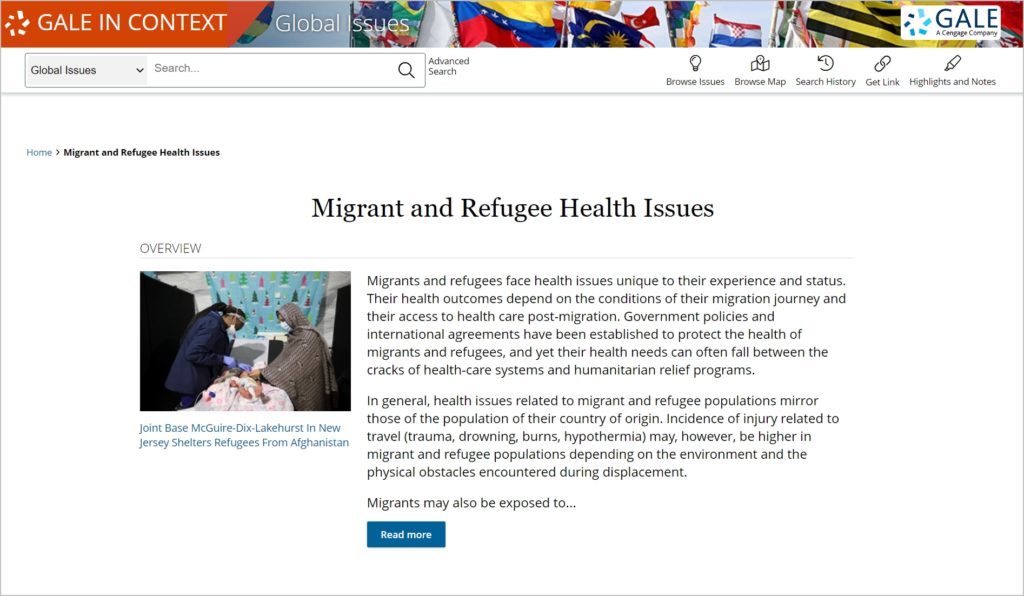|By Gale Staff |
As the world waits out the conflict in Ukraine, many are asking what has become of the people in this war-torn area. To date, millions of refugees have fled the country in record numbers to escape Russian attacks on Ukrainian soil. According to the United Nations High Commissioner for Refugees (UNHCR), as of May 8, 2022, the number of refugees fleeing Ukraine is at 5.8 million and climbing.1 The exodus has recently been characterized by Filippo Grandi, high commissioner of the United Nations’ refugee agency, as one of the fastest he has witnessed in almost 40 years. Where are they all going?
The majority of Ukrainian refugees have gone to Poland, while others have left for Romania, Hungary, Slovakia, Russia, and Moldova, respectively.2 Tens of thousands continue to leave, by car or on foot, risking their lives traveling through war-ravaged areas in search of food, water, shelter, and safety. It’s hard to imagine what they must be feeling after their lives have been completely upended and the thriving metropolitan areas, villages, and farmlands in which they once lived have been leveled by heavy artillery.

Whoever. Wherever. Whenever. Everyone has the right to seek safety.
For World Refugee Day, a United Nations observance on June 20 each year, we want to take a moment to acknowledge the mass exodus at this important crossroad. It’s difficult to understand the impact contemporary events will have on the millions forced to flee their homes, as well as citizens of those countries on the receiving end of this migration who are embracing refugees en masse. Perhaps it’s not surprising that, given these events, the theme of this year’s World Refugee Day is “Whoever. Wherever. Whenever. Everyone has the right to seek safety.”3
If you’re not familiar with the term, “refugees” are people who seek safety in other countries. The United Nations defines a refugee as “someone who is unable or unwilling to return to their country of origin owing to a well-founded fear of being persecuted for reasons of race, religion, nationality, membership of a particular social group, or political opinion.”4 Just like the Ukrainians, people of various countries become refugees because of situations they didn’t choose; they are people who want to live life in peace.
Other types of people who may be classified as refugees (although legally they might not be considered refugees) include internally displaced persons—people who remain in their home countries but are forced to flee their homes to find safety—and asylum seekers, meaning people who have entered a new country and seek sanctuary but who haven’t completed the legal process. The term migrant is also used under the umbrella of refugees, although migrants are more accurately people who can choose to seek a new life in another country but will not risk persecution or death if they return home.
Humanity without Borders
While our attention has recently shifted to Ukraine, as of April 2022, the UNHCR, the United Nations Refugee Agency, estimates more than 84 million people around the world have been forced to flee their homes. Approximately 26.6 million of these people would be classified as refugees according to the UNHCR’s mandate/definition—the highest number recorded in history.5
The past few years have been challenging for refugees and those who help them. Refugees have fled conflicts in Syria, South Sudan, Afghanistan, Venezuela, Myanmar, and now Ukraine, all with the COVID-19 global pandemic taking place. It’s important for all of us as global citizens to seek out and reflect on our own sense of humanity in these events.
Life for refugees is incredibly difficult, and the adjustments are tremendous—the challenges include learning new languages, customs, foods, and figuring out how to make a living in a new country. It can be challenging for refugees to get help for their physical and mental health issues, and they may encounter barriers or delays in accessing medical care.
Students can get a feel for what it means for people to flee their own countries and start over again, as they overcome adversity and make new connections on foreign soil, through video assets like the following, which are part of the Gale in Context: Global Issues database:
Watch this video from the New York Times to learn about an Afghan refugee living in Kentucky; she faced the Taliban in Afghanistan and endured a tornado in her new American home.
This AFP News video is about Somali refugees in London who are reconnecting with their traditional arts.
Celebrating World Refugee Day in the Classroom
Reducing prejudice and misinformation is important when teaching about refugees. Many social and emotional learning opportunities can come from such a discussion. Gale databases offer teachers and K-12 and public librarians the opportunity to initiate learning through credible content; leveled overviews for students of different reading abilities; and multimedia, such as audio and video.
Gale In Context: Global Issues captures more than 700 pages of materials covering hot-button topics, including those related to the global refugee crisis. The database is continuously updated to support instructional opportunities related to global current events through news, global viewpoints, reference materials, country information, primary source documents, videos, statistics, and more. These resources are fully accessible through participating schools and public libraries. The portal overview sample includes two Lexile levels (4 and 3) for readers at different reading levels. Students of contemporary global studies interested in the global refugee crisis will also benefit from a more extensive overview.
Experiencing Contemporary Global Issues In Context
To help put things in perspective for your students, you can also check out this video in the Gale In Context: Global Issues portal on the refugee crisis.
- Haseman, Janie, “Millions of Refugees Are Fleeing Ukraine. Where Are They Going?” USA Today, March 19, 2022.
- See note 1.
- UNHCR (website), “World Refugee Day,” accessed June 2, 2022.
- UNHCR (website), “What is a refugee?” accessed June 2, 2022.
- UNHCR (website), “Figures at a Glance,” accessed June 2, 2022.


